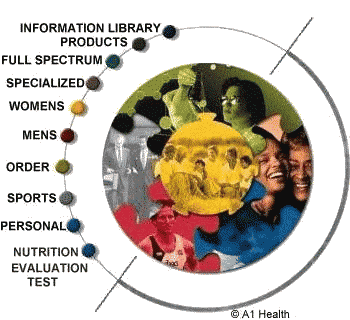COLLOIDAL MINERALS
IRON
Iron (Fe), an essential nutrient that carries oxygen, forms part of the oxygen-carrying
proteins hemoglobin in red blood cells and myoglobin in muscle. It is also a
necessary component of various enzymes. Body iron is concentrated in the storage
forms, ferritin and hemosiderin, in bone marrow, liver and spleen. Body iron
stores can usually be estimated from the amount of ferritin protein in serum.
Transferrin protein in the blood transports and delivers iron to cells.
hemoglobin,ferritin blood IRON
IMPORTANCE:
Its major function is to combine with protein and copper in making hemoglobin.
Hemoglobin transports oxygen in the blood from the lungs to the tissues which
need oxygen to maintain basic life functions. Iron builds up the quality of
the blood and increases resistance to stress and disease. It is also necessary
for the formation of myoglobin which is found only in muscle tissue. Myoglobin
supps oxygen to muscle cells for use in the chemical reaction that results in
muscle contraction. Iron also prevent fatigue and promotes good skin tone.
DEFICIENCY SYMPTOMS:
May result in weakness, paleness of skin, constipation, anemia.
: Severe iron deficiency results in anemia with small, pale, red blood cells
that have a low hemoglobin concentration. Iron deficiency anemia in pregnancy
increases the risk of premature and low birth weight babies. In young children,
iron deficiency is associated with behavioral abnormalities (such as reduced
attention span) and reduced cognitive performance that may not be fully reversible
by iron replacement. In adults, iron deficiency anemia impairs physical work
capacity. In the US, severe iron deficiency anemia is relatively rare. Impaired
iron status is most common in 1-2 year-old children (9.3%), males aged 11-14
years old (4.1%) and females 15-44 years old (6.3-7.2%). This impairment reflects
rapid growth or menstrual iron loss and it is uncommon (2%) in other groups.
Diet recommendations:
The 1989 Recommended Dietary Allowance
|
U.S. RDA FOR IRON
|
babies:
birth to 6 months
6 months to 1 year |
6 mg per day
10 mg per day |
children:
1 to 10 years |
10 mg per day |
men and boys:
11 to 18 years
19 to 51+ years |
12 mg per day
10 mg per day |
women and girls:
11 to 50 years
51+ years |
15 mg per day
10 mg per day |
| pregnant women |
30 mg per day |
| nursing mothers |
15 mg per day |
Food sources:
In the US, grain products are a principal source of dietary iron, followed by
meat, poultry and fish, vegetables, legumes, nuts and soy. Red meat is a rich
source of iron that is well absorbed. Heme iron (about 40% of the iron in meat,
poultry, or fish, and 7-12% of the iron in US diets) is 15-45% absorbed, depending
on iron stores. (Individuals with low iron stores compensate by absorbing more
iron). Nonheme iron, the remaining majority of dietary iron, is 1-15% absorbed.
Absorption is dependent on iron stores and absorption enhancers (e.g., ascorbic
acid, an unidentified factor in meat, poultry and fish) or inhibitors (e.g.,
phytic acid in whole grains and legumes, polyphenols in tea, coffee, or red
wine, calcium in dairy products or supplements) eaten concurrently. U.S refined
grain products are routinely enriched with iron. Iron-fortified formula or cereals
are useful in preventing iron deficiency in infants.
Toxicity:
Iron supplements intended for other household members are the most common cause
of pediatric poisoning deaths in the US. In populations of European origin,
approximately 1 in 300 people have hemochromatosis, a genetic abnormality of
excessive iron stores. Ten percent of these populations carry a gene (are heterozygous)
for hemochromatosis. Researchers are testing hypotheses that high iron stores
may increase the risk of chronic diseases, such as cancer and heart disease,
through oxidative mechanisms.
For further information:
Institute of Medicine, Food and Nutrition Board (1993) Iron Deficiency Anemia:
Recommended Guidelines for the Prevention, Detection, and Management Among U.S.
Children and Women of Childbearing Age. National Academy Press, Washington,
DC.
 LIBRARY LIBRARY
RELATED ARTICLES:
 MORE ABOUT IRON MORE ABOUT IRON
PREVIOUS
PAGE
IODINE
 REQUEST YOUR FREE EAGLE PRODUCT INFORMATION PACK: INFOPACK@eagle-min.com REQUEST YOUR FREE EAGLE PRODUCT INFORMATION PACK: INFOPACK@eagle-min.com

INDEPENDENT
SupraLife Distributor
For personal service Call:
A1 Health
TOLL FREE ORDER EXPRESS HOT LINE :888-441-4184
9 AM Till 7PM EST
 e-mail: info@colloidal-min.com e-mail: info@colloidal-min.com
|
